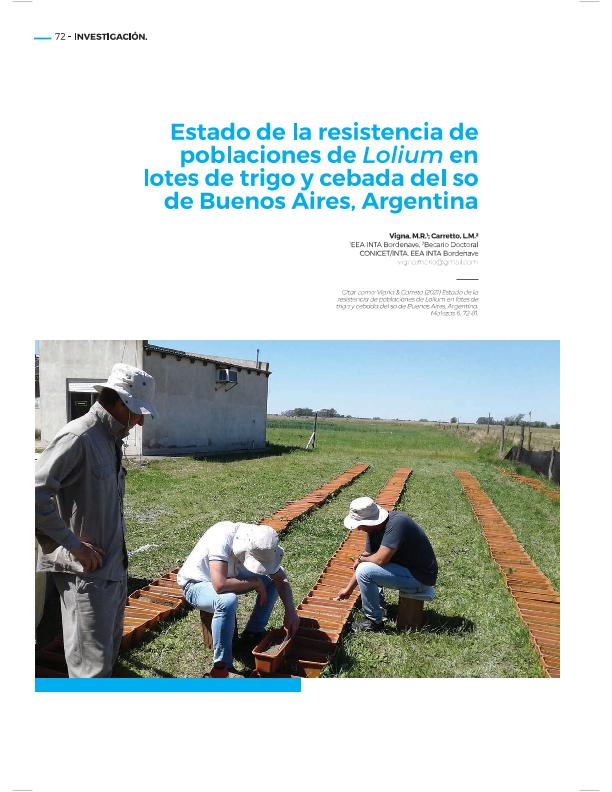Artículo
En 115 poblaciones de Lolium (raigrs) de 10 partidos del SO de Buenos Aires se evalu la resistencia a herbicidas a partir de muestras cosechadas en diciembre de 2016. Las semillas se sembraron en macetas donde evaluaron cinco tratamientos herbicidas: 1) glifosato (inhibidor de la EPSPS) 1000 g e.a. ha-1, 2) pinoxaden (inhibidor de la ACCasa, fenilpirazolina, DEN) 40 g p.a. ha¹, 3) (iodosulfuron 12,5 g p.a. ha¹+mesosulfuron 1,95 g p.a. ha¹) + metsulfuron 3 g p.a. ha¹ (inhibidores de la ALS), 4) cletodim (inhibidor de la ACCasa, ciclohexanodionas, DIM) 192 g p.a. ha¹ y 5) haloxifop (inhibidor de la ACCasa ariloxifenoxipropionatos, FOP) 81 g p.a. ha¹. Los herbicidas se aplicaron sobre plantas de Lolium con 3-4 macollos. Se evalu el control visualmente y, nalmente, se efectu el conteo de plantas que sobrevivieron a los tratamientos en cada una de las macetas para calcular el porcentaje de plantas sobrevivientes. Se identicaron tres niveles: poblaciones susceptibles (sin sobrevivencia), poblaciones con resistencia en desarrollo (1 a 19% de sobrevivencia) y poblaciones resistentes (con 20% o ms de sobrevivencia). El 57 % de las poblaciones fueron resistentes a inhibidores de la EPSPS, 26,9 % a inhibidores de la ALS, y 39,7 %, 10,3 % y 8,9 % a inhibidores de la ACCasa DEN, FOP y DIM, respectivamente. El 4,5% de las poblaciones fueron resistentes a los 5 herbicidas, el 11 % fue susceptible a todos y el 28 % resistente a 2 o ms herbicidas. Se evidenci un incremento de resistencia mltiple, respecto a un relevamiento efectuado en 2013, con el fuerte crecimiento de resistencia al inhibidor de la ESPS y menor incremento para inhibidores de ALS y ACCasa DEN. El anlisis de componentes principales mostr relacin entre la sobrevivencia a inhibidores de la ACCasa FOP y DIM (resistencia cruzada) e inhibidores de ALS y ACCasa DEN (resistencia mltiple), y en menor medida, con los casos de sobrevivencia a inhibidores de la EPSPS. Lo registrado en este relevamiento refuerza la idea de que el manejo de la resistencia basado solamente en cambiar sitios de accin de herbicidas en aplicaciones selectivas en cultivos de trigo y cebada es insuciente Herbicide resistance was evaluated in 115 populations of Lolium (ryegrass) in 10 districts of the SW of Buenos Aires from samples harvested in December 2016. The seeds were sown in rectangular pots, achieving between 17 and 35 plants per pot. They remained outside and sheltered fromthewinds. Five herbicide treatments were evaluated: 1) glyphosate (EPSPS inhibitor) 1000 g i.a. ha-1, 2) pinoxaden (ACCase inhibitor, phenylpyrazoline, DEN) 40 g i.a. ha¹, 3) (iodosulfuron 12.5 g i.a. ha¹ + mesosulfuron 1.95 g i.a. ha¹) + metsulfuron 3 g i.a. ha¹ (ALS inhibitors), 4) clethodim (ACCase inhibitor, cyclohexanediones, DIM) 192 g i.a. ha¹ and 5) haloxyfop (aryloxyphenoxypropionates ACCase inhibitor, FOP) 81 g i.a. ha¹. Herbicides were applied on Lolium plants in 3-4 previously counted tillers. Visual control evaluations were made and nally the plants that survived the treatments were counted in each of the pots to calculate the percentage of surviving plants. Three levels were identied: susceptible populations (without survival), developing resistance (1 to 19% survival) and resistant (with 20% or more survival). The 57% of the populations were resistant to EPSPS inhibitors and 26.9, 39.7, 10.3 and 8.9% to ALS inhibitors, ACCase inhibitors DEN, FOP and DIM, respectively. The 4.5% of the populations were resistant to the 5 herbicides, 11% were susceptible to all and 28% resistant to 2 or more herbicides. An increase in multiple resistance was evidenced, with respect to a survey carried out in 2013, with the strong growth of resistance to ESPS and a lower increase for ALS and ACCase DEN. Principal component analysis showed a relation between survival to inhibitors of the ACCase FOP and DIM (cross resistance) and ALS and ACCase DEN (multiple resistance), and in a lesser extent with the cases of survival to EPSPS inhibitors. These results rearm the idea that resistance management based solely on changing sites of herbicide action in selective applications in wheat and barley crops is insucient.
Estado de la resistencia de poblaciones de Lolium en lotes de trigo y cebada del So de Buenos Aires, Argentina
Fecha de publicación:
12/2021
Editorial:
Asociación Argentina de Ciencia de las Malezas
Revista:
Malezas
ISSN:
2683-9180
Idioma:
Español
Tipo de recurso:
Artículo publicado
Clasificación temática:
Resumen
Archivos asociados
Licencia
Identificadores
Colecciones
Articulos(SEDE CENTRAL)
Articulos de SEDE CENTRAL
Articulos de SEDE CENTRAL
Citación
Vigna, Mario Raul; Carretto Nocolo, Luis Miguel; Estado de la resistencia de poblaciones de Lolium en lotes de trigo y cebada del So de Buenos Aires, Argentina; Asociación Argentina de Ciencia de las Malezas; Malezas; 6; 12-2021; 72-81
Compartir




